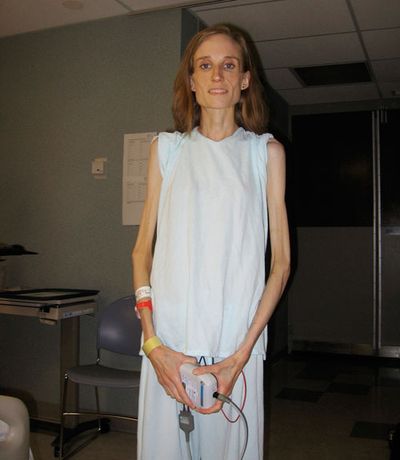Starvation Nation: Inside a Groundbreaking Eating Disorder Facility
While most of America focuses on obesity, anorexia is claiming new patients in record numbers. At a cutting-edge treatment facility, we investigate the epidemic one expert is comparing to AIDS.

At 26, Rachel Craig has never had a long-term job, gotten her period, or moved out of her parents' house. She has the bones of an 80-year-old and, thanks to an adolescence spent in treatment centers, few close friends. She eats almost every meal at home with her mother. "Co-eating" is the only way she can keep her weight at 105 pounds, the minimum her parents set after she was rushed to the hospital last summer, near death at 61 pounds after living on sugarless gum for months. She's out of the hospital now, but recovery has been hard. "Anorexia's a competitive disease," she says, her brown hair falling over her shoulders. "You look at girls further along the recovery path and think they're getting fat." She's been sick for 15 years.
This is the reality of anorexia: patients in and out of hospitals for years, unable to grow up, their families desperate to end the secret starvation rituals. But at one new treatment facility, Denver's Eating Recovery Center (ERC), doctors are fighting the disease with cutting-edge techniques. Patients wear armband sensors that track every calorie they burn (they're sold as weight-loss tools — ERC is the only place that utilizes them for eating-disorder treatment), and use biofeedback finger probes, which display heart rate and body temperature, to manage anxiety through breathing exercises. In "flexibility training" (originally developed to help traumatic brain injury victims), patients take a different seat in each therapy session or brush their teeth with the opposite hand. The change in routine creates new brain neurons, disrupting obsessive thoughts.
The Denver doctors say mixing these different tactics with traditional treatments, like movement and art therapy, is key to stopping the disease. Because today, 40 years after anorexia and bulimia started sending young white women to hospitals across the U.S., eating disorders have cropped up in kindergartners, senior citizens, boys, Hispanics, and African-Americans. No demographic is safe, and medical professionals are scrambling to combat what has become a burgeoning public health crisis. The most provocative analogy comes from Craig Johnson, Ph.D., who compares the spread of the sickness to that of HIV/AIDS. "The pursuit of thinness is 'contagious'" behaviorally, says Johnson, who has done pioneering research on the biological basis of eating disorders, and is now chief clinical officer at the Eating Recovery Center.
"We've moved away from this as a Caucasian, upper-middle-class, 'princess' disease. It's everybody's disease," says Dr. Ovidio Bermudez, medical director of child and adolescent services at ERC, which treats patients as young as 10. He's seen 13-year-old boys on the brink of kidney failure after shunning carbs and gorging on protein; 47-year-old mothers undereating and running 15 miles a day after a double mastectomy; 30-something housewives hospitalized during pregnancy to stop excessive exercise; and diabetic Ivy League med students manipulating their insulin injections. These new conditions — "orthorexia," "pregorexia," "diabulimia" — demand a daring, innovative approach.
Rachel Craig's anorexia started when she was 11, in the summer of 1996. She'd just finished fifth grade in Colorado Springs, 60 miles from Denver. An avid reader, she loved Madeleine L'Engle's A Wrinkle in Time, and playing softball with her younger sister, Anna. But the year had been hard for her. Her friends, a group of dancers, started a new clique without her. At 4'10" and 100 pounds, she was self-conscious. Boys at school called her fat; she felt like the chubby one in family Christmas photos. She swore that sixth grade would be different. She'd be thinner. Popular.
That summer, Rachel started jogging three miles a day. Researching nutrition, she discovered what calories were. As the months went by, she ate less. If she wasn't a little hungry, how was she going to get thin? By sixth grade, she'd lost 30 pounds, bringing a solitary plum to school for lunch. Any excitement she'd felt about being skinny was overshadowed by an obsession with food. When not eating in front of her classmates at lunch became embarrassing, she started making sandwiches — diet bread, mustard, and lettuce — so they'd think she was normal, but after school, she'd get straight on the StairMaster for 45 minutes a day. By Christmas, "I wasn't even aware of the world around me anymore. I was completely cut off," she says.
Horrified, Rachel's mother, Linda — a phys-ed teacher at another middle school nearby — transferred her there in January so they could eat lunch together. But Linda felt more helpless than ever as she watched Rachel pick every bit of pasta out of her wonton soup one day, hiding it in her napkin. At the new school, the popular girls were fascinated by Rachel and shared their Chapstick with her between classes — finally, she had new friends. But by April, she weighed 50 pounds — half her original weight. "We were in a panic," says Linda, who had suffered from her own eating disorder during college. Pediatricians, therapists, and emergency-room doctors were useless; Rachel's therapist said she needed serious help but offered no referrals. "We got kicked off the gangplank," Linda says, recalling her desperation. "We needed an anchor, but there was nothing in sight." At home, Rachel's parents would beg, threaten, and bribe her to eat. She'd apologize and promise to try, but the look on her face reminded Linda of a caged animal. The sockets around her blue eyes became hollow; she'd lapse into trances at night, babbling. Finally, her father checked her into a child psych ward at the local hospital. Too weak to refuse food, she ate, and emerged from her fog a few days later.
Stay In The Know
Get exclusive access to fashion and beauty trends, hot-off-the-press celebrity news, and more.
Relieved, her parents sent her to stay with her grandmother for the summer before seventh grade. By fall, she'd gained 50 pounds, and everyone thought she was fully recovered. "I'd never heard of eating disorders. I didn't know there was such a thing as eating too little," says Rachel now. Her mother has a different view. "My downfall was that when I had my disorder, I wasn't nearly as good at it as she is," says Linda ruefully. "I just always assumed Rachel would come out of it. I danced on the edge with my anorexia. She was all the way in the tank."
As an anorexic preteen in 1996, Rachel was a rarity — in the mid-'90s, little was known about eating disorders in kids. Not so today. Between 2000 and 2006, eating-disorder hospitalizations for children under 12 more than doubled, according to the National Eating Disorders Association (NEDA). Experts blame teen stars, like Lindsay Lohan and Demi Lovato, who struggle publicly with eating issues, and say the Web worsens the problem by supplying unhealthy images — a recent study even linked Facebook with eating disorders, finding that time on the site was tied to negative body image and dieting. And now men's magazines tout six-pack abs; Russell Brand has said he was bulimic; and Lady Gaga's boyfriend, Luc Carl, is writing a book about the "drunk diet" that helped him drop 40 pounds. The potent combination of 24/7 social media and celebrity obsession has created a dangerous cultural undertow for anyone prone to an eating disorder.
Unfortunately, science hasn't kept up with the growing patient pool. Research on eating disorders has always been underfunded, thanks to their reputation as women's diseases of vanity. In 2005, the National Institutes of Health gave out just $12 million in anorexia grants. And it's been hard to get public sympathy for a disease whose patients sometimes seem complicit in their own suffering. At ERC, for example, staffers recently noticed a foul smell in one of the bedrooms. They soon uncovered the source: a shoe that a patient had craftily stuffed full of bits of food from almost a week's worth of meals, then stashed away. (Clogs, hooded sweatshirts, and shirts with pockets are discouraged at mealtimes for this very reason.) Doctors have made strides in understanding the genetic nature of eating disorders, finding that women with family histories of anorexia are 12 times likelier to get it. (Scientists haven't pinpointed one eating-disorder gene; the interplay of several is likely the catalyst.) Advances like these have helped increase awareness, bumping eating-disorder funding to an estimated $27 million in 2011, although, by comparison, breast cancer research will total $763 million.
Treatment has come a long way since the mid-'70s, when anorexics were force-fed high-calorie "malteds" and given electroshock therapy. But results are still hit-or-miss, even at state-of-the-art centers like ERC, where doctors talk about the "rule of thirds": A third of patients get better in one to three years; a second third in four to seven years; and the final third take much longer. For patients who are sick for more than 20 years, one study suggests 20 percent die from the disease — or suicide.
Doctors do know that eating disorders, which are involuntary and genetic mental diseases, like depression, schizophrenia, or OCD, follow a pattern. Patients with a certain character trait — "high harm avoidance," in medical-speak — are more easily upset by puberty or big life events. To get control, they diet. Sounds innocent: Who hasn't wanted to slim down before a new job or a wedding? But in certain people, weight loss exposes a genetic vulnerability to an eating disorder.
What makes the disorders so hard to treat is their way of turning the body's normal regulatory mechanisms against themselves. Malnutrition slows the brain's hormone production, "numbing" intense emotions. So as anorexic patients starve, they feel calmer. Hunger pangs are now a reassurance they won't get fat. In another twist, the more weight they lose, the fatter they see themselves. It's not a problem with their vision. The more they starve, the harder it is to keep going — the body wants to eat. So the mind produces motivation in the form of an obese reflection rippling with rolls of fat. The delusion is a rationale for continuing to starve, created by brain chemistry doctors don't understand.
Seventh grade was great for Rachel. She got A's and made friends, and her weight hovered around 105 pounds. Then, in eighth grade, things got worse. While her mother, Linda, ran the school concession stand, Rachel sat in the back eating chocolate bars. Upset by her weight gain — she was 25 pounds heavier by ninth grade — she started vomiting. From age 13 to 16, she'd skip breakfast and eat a tiny lunch. At home after school, she binged on Twinkies, Little Debbie cakes, and peanut butter mixed with vanilla ice cream. Then, panicked, she'd run to the upstairs master bathroom, lock the door, flip on the radio, and run the bath. Sitting in the tub, she'd vomit into a 54-ounce Big Gulp cup, emptying it into the toilet. She'd shower, clean up, and eat a small, healthy dinner to avoid suspicion.

By sophomore year of high school, at 5'3", Rachel weighed 145 pounds. She'd quit student council — she'd been secretary of her freshman class — and was distant from friends. Afternoons were for her secret ritual, which she says she "looked forward to every day, all day." One afternoon at the end of her sophomore year, she was so ravenous driving home that she went too fast and got a speeding ticket.
During the fall of her junior year, Rachel stopped the bulimia but started restricting her calories again. Her weight plummeted, dropping steadily over the next few years. By December 2004, as an English major at the University of Colorado at Colorado Springs, she weighed just 82 pounds, although she was now 5'4". Her doctor, psychiatrist, and counselor checked her into treatment at the Eating Disorder Center of Denver (a different facility from the ERC). She left three months later and spent the spring recovering. In 2007, healthy, she started graduate school.
In the fall of 2008, Rachel, now 23, started teaching English at a high school near her parents' house. The new job took a serious toll on her eating habits: Constantly cold, she drank diet hot chocolate all day and wore stockings with leggings and pants pulled over them. Shocked by her relapse, her parents took her out of work. By Christmas, just 71 pounds, she looked gaunt and haunted, the thinnest she'd ever been. Somehow, she convinced her parents she was improving, but by June 2009, she still hadn't gained a pound. They checked her into the newly opened Eating Recovery Center that month; homesick and lonely, she cried to them every night on the phone.
The ERC, located on two floors of a hospital building in Denver, looks like an upscale ski lodge or dormitory. Patients chat by an open fireplace; bedrooms are full of picture collages and stuffed animals. But despite the spa-like bathrooms and wide-windowed conference rooms where therapy takes place, life here is regimented. Bedroom doors are locked so patients can't exercise in secret. Bathroom trips are made with staffers, who check toilets before flushing. Meals must be finished in 30 minutes, and nurses and therapists are constantly on the lookout for patients smearing butter under the table, casually patting napkins on top of their chicken to remove oil, dropping food stealthily on the floor, or even hiding yogurt in their ears or hair — "compensatory behaviors" patients use to get the food off their plates without eating it. (Anyone caught manhandling food like this has to make up the calories with Boost, an energy drink.) On the cafeteria wall, disordered behaviors and substitutes are clearly posted: "Use hands to eat a sandwich," not utensils; "use condiments in moderation." The goal? Relearn to eat.
On a winter day, 12 ERC patients gather for a community meeting. At these sessions, with therapists present, the group checks in with one another, sharing concerns with their own behavior or issues they've noticed. Ranging in age from 19 to over 50, the women look like college students during finals, wearing stylish leggings or sweats, shearling boots, fleeces, and T-shirts. (Both overly baggy clothes and tight garments are discouraged.) One woman has a feeding tube taped to her cheek; another holds a stuffed bear. Going around the circle, they share their "successes" — one accidentally put on mismatched socks that morning but didn't change them, despite feeling insecure about it — and "accountabilities." A blonde 35-year-old says her upcoming release is making her anxious, and she fears taking it out on her food, mixing inappropriately or cutting or chewing too much. Another woman asks how they can help her manage that at lunch. She asks for subtle reminders, like eye contact or a nudge. She also asks the other women not to go through the box of thin clothes she's throwing out ("sick" clothes in ERC lingo). She doesn't say why, but it's obvious: If anyone else could fit into the clothes she can't wear anymore, it would be extremely traumatic.
In a "values" group meeting later on, patients are asked to divide a pie chart according to how much time they spend thinking about their eating disorder. One girl, her brown hair in a ponytail, says just 16 percent of her circle is free for other activities. "We experience happiness when we align our lives with our values," a therapist says. "How can we make your true values take up the whole pie?" Many patients are so consumed with thoughts of staying thin that even the simplest activities become a sinister means of losing weight. Bermudez remembers spotting a patient in a Target parking lot; he'd just had a serious discussion with her about her high risk for bone fractures. At Target on a supervised ERC outing, she was turning cartwheels around the parking lot for surreptitious exercise. "She came up, and we met face to face," says Bermudez. "I couldn't believe it."
One of ERC's boldest moves has been creating a brand-new therapeutic framework, the "pillars of recovery," which highlights patients' personal ideals — relationships, faith, learning — and recovery principles, like "mindsight" (the ability to analyze your own thoughts). The change-based psychotherapy doctors have used for years forces patients to disown the anxiety that causes their disorders; the new approach helps them accept and manage it, a revolutionary idea in the stagnant world of eating-disorder treatment.
Nutritional stabilization, to normalize hormones, is also key. Meals are difficult here, and it's hard to reconcile the scene inside — women dropping bits of chicken on one another's chairs, or doing frenzied jumping jacks at night between nurse rounds — with the current public health obsession, obesity. According to the NIH, 97 million Americans are overweight or obese. "My patients are the casualties of the war on obesity," says Dr. Ken Weiner, founder of five treatment centers (including ERC), and Rachel's doctor. "Parents ask how to eating-disorder-proof a child: Never put your kid on a diet." Michelle Obama's crusade against childhood obesity and the addition of BMIs to report cards in some public schools make eating-disorder experts shudder. They believe the anti-fat campaign will trigger a whole new health crisis for the 11 million Americans who are anorexic or bulimic.
Doctors hope for a cure within 30 years — a custom drug or early gene intervention technique. Experiments comparing the brains of anorexic and nonanorexic subjects via MRI and PET technology are promising because they may reveal how anorexic brains really work. Until then, eating disorders' status as mental illnesses mean families struggling to pay for treatment — which can cost up to $1,000 a day — can take advantage of mental-health parity laws, expanded by President Obama to omit treatment limits for psychological diseases.
In November 2009, Rachel left ERC at 96 pounds. She'd hated the food — Italian paninis and Mandarin-orange salads — begging ERC's dietitian for chicken breasts with rice. Ecstatic to be free, "I assumed my weight would maintain itself," she says. For a while, it did. By January 2010, she was working as a substitute teacher at her mother's school and as a nanny for a local family. But by February, her psychiatrist and counselor were recommending she get help again. She'd lowered her daily calorie count to 600, and was chewing packs of gum and NutraSweet to blunt her hunger. After months of this, she was weak. Nausea and headaches kept her in bed until noon. Finally getting up, she'd rest after every movement: Stand up, rest. Put on socks, rest. She couldn't climb stairs, and was too tired to go to the park. Her charges played video games.
Though she continued to work as a nanny through June, she'd lie awake in bed and think about dying, imagining her mother finding her dead from a heart attack. In the nighttime silence, her mind raced. "I'd wonder, There's only five hours till morning — am I going to make it?" She didn't bother weighing herself and avoided mirrors, knowing she looked awful, but for doctor visits, she'd tie 10-pound ankle weights to each leg, under her pants, and chug water before getting on the scale. "I had an overwhelming sense of anxiety and fear," she says. "I didn't want to die, but I felt like I was almost there."
Finally, in July 2010 — one year ago — her psychiatrist called to say Rachel needed to go to the hospital. Now. So Linda took her to the doctor. As they walked to the waiting room from the parking garage, she noticed her daughter's strange gait and, frisking her, discovered the weights. "What are you doing?!" she asked, incredulous. "I was a basket case," says Linda now. "We thought she weighed 80 pounds — which was awful enough — but it was so much worse. I've learned crying doesn't help. You get numb instead." But when she sat down with Rachel's physician, the doctor herself was in tears. "She said, 'We're going to lose her,'" says Linda. Her daughter was just 61 pounds. Although Rachel barely spoke that afternoon, she was flooded with relief at the prospect of being hospitalized. Maybe now she wouldn't die.
By August, she'd gained 10 pounds in the hospital and returned to the Eating Recovery Center — her third stint at treatment, the second there, in 15 years. Forced to eat 3,600 calories a day, she was constantly tempted to cut back. But, having come so close to death, she had new motivation. "I reminded myself every day why I was there — my family, my future," she says. In December 2010, at 96 pounds, she left.
Today, 26 years old, Rachel weighs 105 pounds (her goal is 115), and says she is optimistic about the future. She's renewing her teaching license and dating a young Army officer, Chris, whom she met through church friends. Before they go out, she checks the restaurant website for healthy options. When she was served Thai food with beef, noodles, and peanut sauce — three of her scariest foods — at his friends' house for dinner recently, she ate a normal serving, using ERC skills. "I just looked at the worst-case scenario: I'd gain a pound. And that's not that big a deal. I could always lose it." No one there realized what a triumph it was for her (Chris knows only the basics about her disorder), but "it was just another dinner for them, and it felt good to have it be another dinner for me, too," she says.
Despite her new outlook, Rachel has some regrets. She knows her eating has disconnected her from the people around her, and physically, "I wonder if I'd be more intelligent, or taller, if I hadn't restricted during my pivotal growth years," she says. She takes several vitamins and supplements to improve her bone density, plus Wellbutrin (an antidepressant) and Cymbalta, to combat anxiety and depression. She sees a counselor weekly and a psychiatrist monthly. Hardest of all, however, has been letting a central part of her identity go. "The feeling other people get from doing a good job at work, or raising kids who are productive in society, or planting a garden and seeing it bloom — that's the feeling I get from losing weight," she says. "Life moves slower, and I feel like I'm doing the right thing. After all, this is what every American desires to do. And I can do it."
-
 This Royal Child Has Left Siblings Behind With Staggering 900% Popularity Jump
This Royal Child Has Left Siblings Behind With Staggering 900% Popularity JumpGoogle searches have skyrocketed for this member of the Royal Family.
By Kristin Contino
-
 Combining These Two Spring Nail Trends Was a Stroke of Genius
Combining These Two Spring Nail Trends Was a Stroke of GeniusIt’s giving futuristic fashion girl.
By Samantha Holender
-
 The Elegant Blouse Fashion People Will Be Wearing With Jeans the Entire Summer
The Elegant Blouse Fashion People Will Be Wearing With Jeans the Entire SummerThe definition of a "nice top."
Partner Content Created With Who What Wear.By Natalie Munro
-
 There's a Huge Gap in Women's Healthcare Research—Perelel Wants to Change That
There's a Huge Gap in Women's Healthcare Research—Perelel Wants to Change ThatThe vitamin company has pledged $10 million to help close the research gap, and they joined us at Power Play to talk about it.
By Nayiri Mampourian
-
 BetterMe Will Make Your New Year’s Resolutions Last the Other 12 Months
BetterMe Will Make Your New Year’s Resolutions Last the Other 12 MonthsSponsored BetterMe: Health Coaching uses a psychology-based program to approach your health goals from all angles, so they stay within reach.
By Sponsored
-
 Everlywell's At-Home Test Kits Are 40% Off
Everlywell's At-Home Test Kits Are 40% OffThe testing company is offering big savings on some of their most popular kits.
By The Editors
-
 Senator Klobuchar: "Early Detection Saves Lives. It Saved Mine"
Senator Klobuchar: "Early Detection Saves Lives. It Saved Mine"Senator and breast cancer survivor Amy Klobuchar is encouraging women not to put off preventative care any longer.
By Senator Amy Klobuchar
-
 I'm an Egg Donor. Why Was It So Difficult for Me to Tell People That?
I'm an Egg Donor. Why Was It So Difficult for Me to Tell People That?Much like abortion, surrogacy, and IVF, becoming an egg donor was a reproductive choice that felt unfit for society’s standards of womanhood.
By Lauryn Chamberlain
-
 The 20 Best Probiotics to Keep Your Gut in Check
The 20 Best Probiotics to Keep Your Gut in CheckGut health = wealth.
By Julia Marzovilla
-
 Simone Biles Is Out of the Team Final at the Tokyo Olympics
Simone Biles Is Out of the Team Final at the Tokyo OlympicsShe withdrew from the event due to a medical issue, according to USA Gymnastics.
By Rachel Epstein
-
 The Truth About Thigh Gaps
The Truth About Thigh GapsWe're going to need you to stop right there.
By Kenny Thapoung